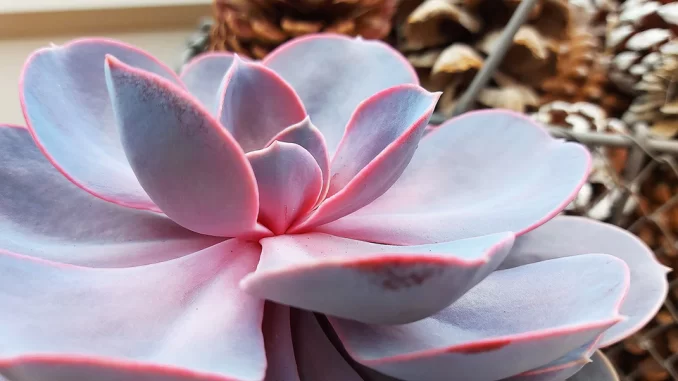
Last Updated on by Sabina
Echeveria is a genus of succulent plants that belongs to the Crassulaceae family. These plants are native to semi-desert regions of Central America, Mexico, and northwestern South America. Echeverias are popular among succulent enthusiasts. People often grow Echeveria succulents as ornamental plants because of their striking rosette-shaped foliage and vibrant colors.

The leaves of Echeveria plants are thick, fleshy, and arranged in a rosette formation. They come in a wide range of shapes, sizes, and colors. Including shades of green, blue, purple, pink, and even red. Some species also have interesting textures or patterns on their leaves, adding to their visual appeal.
Echeverias thrive in dry conditions, which makes them well-suited for arid or drought-prone areas.They have adapted to store water in their leaves, allowing them to withstand periods of low rainfall. As succulents, they have efficient water storage mechanisms and can tolerate short periods of drought.
Echeveria Care
Caring for Echeverias is relatively easy, as they have minimal water and maintenance requirements. Here are some key care tips:
Light: Echeverias prefer bright, indirect sunlight. They can tolerate some direct sun but may need protection from intense afternoon rays, especially in hot climates.
Watering: Allow the soil to dry out between waterings. Overwatering can lead to root rot and other issues, so it’s important to avoid excessive moisture. Water thoroughly and then let the soil dry before watering again.
Soil: Use a well-draining soil mix specifically formulated for succulents or cacti. Good drainage is crucial to prevent waterlogged soil, which can cause root rot.
Echeverias require protection from freezing temperatures as they are generally not frost-tolerant.
To propagate Echeverias, you can use leaf cuttings or offsets, also known as “pups.” Leaf cuttings should be placed on well-draining soil to allow them to develop roots and establish new plants. Pups can be gently separated from the mother plant and planted individually.
Pest and Disease Control: Echeverias are generally resistant to pests and diseases. However, they may occasionally encounter issues like mealybugs or fungal infections. Regular inspection and appropriate treatment, if necessary, can help maintain their health.
Echeverias can be grown both indoors and outdoors, depending on the climate and light conditions. They make beautiful additions to rock gardens, succulent arrangements, containers, and even as houseplants. With their unique shapes, colors, and resilience, Echeverias add a touch of natural beauty to any space.
Echeveria Flower
Echeveria plants are known for their beautiful and often showy flowers that bloom atop tall stalks called inflorescences. The flowers of Echeveria come in a variety of colors, including shades of pink, red, orange, yellow, and white. They typically have a bell-shaped or tubular form, with petals that may be fused or separate.
The flowering period of Echeverias varies depending on the species and growing conditions. Generally, Echeverias bloom during the spring and summer months. Sending up long stems that emerge from the center of the rosette of leaves. These flower stalks can range in height from a few inches to several feet, depending on the species.
The actual flowers of Echeverias are usually small. But they are often arranged in clusters or dense clusters along the inflorescence, creating a visually striking display. Some Echeveria species have flowers with contrasting colors. Such as red petals with yellow tips or pink petals with white edges, adding to their overall attractiveness.
The duration of Echeveria flowers varies, but they typically last for several weeks. Providing a burst of color and beauty during the blooming period. After the flowers fade, the stalks can be pruned back to encourage new growth and maintain the plant’s overall appearance.
It’s important to note that while Echeveria flowers are certainly a delightful aspect of these plants. They are not the primary feature that attracts many enthusiasts. The main allure of Echeverias lies in their rosette-shaped foliage. Which often displays stunning colors, patterns, and textures even without the presence of flowers.
Providing appropriate care, including adequate sunlight. Well-draining soil, and proper watering, can encourage healthy growth and promote the likelihood of Echeveria plants producing flowers. However, it’s important to keep in mind that not all Echeveria species will bloom. And flowering can also depend on factors such as the age and health of the plant.
Overall, the flowers of Echeveria plants add an extra touch of charm to these already captivating succulents. Making them a favorite among succulent enthusiasts and gardeners alike.
Echeveria Succulents
Echeveria succulents are a diverse group of plants that belong to the Echeveria genus, which is part of the Crassulaceae family. These plants are native to arid regions of Mexico, Central America, and parts of South America. Echeverias are highly sought after for their striking rosette-shaped foliage, which comes in a wide range of colors, sizes, and textures.
One of the distinguishing features of Echeveria succulents is their thick, fleshy leaves that store water. This adaptation allows them to survive in dry conditions and makes them excellent choices for arid or drought-tolerant gardens. The leaves are often arranged in compact rosettes, which can vary in size from a few centimeters to several inches in diameter.
The leaves of Echeveria succulents come in a stunning array of colors, including shades of green, blue, purple, pink, red, and even black. Some species have leaves with vibrant patterns or edges, adding to their visual appeal. The leaves may be smooth, fuzzy, or have a powdery coating, depending on the species.


